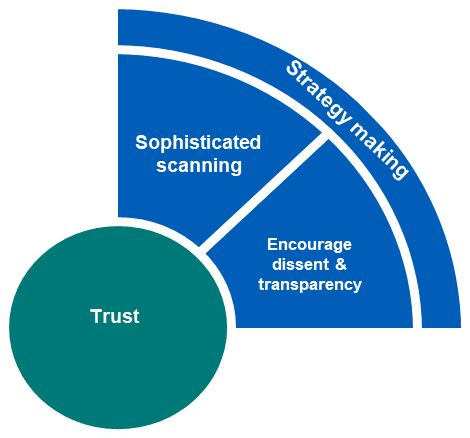Leading through flux: how you can approach digital tran Leading through flux: how you can approach digital transformation
Leading transformations has always been tough. And in the last few years, it’s only become more complex with greater uncertainty and disruption. Today, organisations are not just tweaking parts of themselves, they are fundamentally rethinking their strategies, products and services.
We have been closely looking at what this means for leadership teams during digital transformations. In working with clients across sectors, we have insight into what works and areas where teams often face roadblocks. Our ‘Leading through flux’ model identifies key enablers for staying agile and delivering change in a fast-changing environment. It defines the thinking for working through common challenges and creating lasting change.
As humans, we are creatures of habit. People, culture and established ways of working make transformation hard; it’s not the technology or processes. Given that people are at the heart of change, leaders need to focus on relationships with customers and staff. As we found in the KPMG 2021 CEO Outlook, leaders must stay true to their purpose and values while remaining agile.
In our model with trust at its core, there are four key parts to achieve this – Strategy Making, Test and Learn, Execution and Sustainability.

Strategy Making: are you keeping on top of changes and listening to peers?
To deliver on digital transformation today, you have to be in tune with what’s happening around you, be prepared and listen to colleagues who think differently. You are likely to get left behind if you remain insulated.
On the other hand, with an informed and agile strategy, you can manage to stay on track. For instance, for one of our clients, we moved 400,000 learners from face-to-face learning to virtual learning within a month. Even though no one could predict the pandemic and its effects, we couldn’t have delivered the learning programme without accounting for some disruption in our strategy.

Sophisticated scanning
With fast-changing market dynamics, leaders may need to change strategy to match emerging opportunities. We call this strategic flux. This may include changes to the external context (e.g., customers’ requirements, availability of technology, cost pressures, vendors, political considerations, regulations, etc.) and internal context (shifting priorities, funding, etc.). Successful leaders scan their environment in an unbiased and sophisticated way. They stay on top of emerging developments and their impact on business.
With this awareness, they are in a better position to come up with new ideas and solutions. They are also able to identify barriers and pivot as required. Transformation leadership teams can formalise this scanning process, for example, by building in time on a regular agenda to consider external trends or nominating team members to track specific trends (regulatory, technological, political, etc).
Encourage dissent and transparency
We have seen that start-up founders are willing to pivot business models more readily than corporate leaders. Their preparedness – and even desire – to hear tough feedback on their product, service or approach is critical.
Successful digital transformation leaders also actively seek and encourage real challenge, counter-views, a good ‘kicking of the tyres’ by internal customers and other informed stakeholders. Less successful leaders are fixated on their chosen approach and avoid feedback or dissenting views. In a world of strategic flux, you won’t reach far with the latter approach.
Leadership teams need to set a culture where colleagues feel safe and incentivised to challenge assumptions or decisions. They can do this by building in mechanisms, for example, by implementing a design-thinking ethos to ensure customers are involved throughout the design and build phases.








